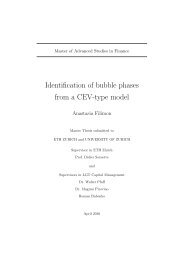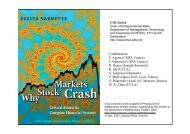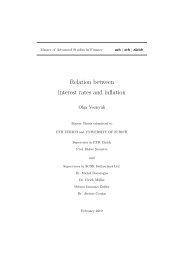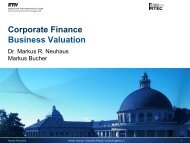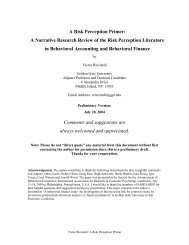Tail Dependence - ETH - Entrepreneurial Risks - ETH Zürich
Tail Dependence - ETH - Entrepreneurial Risks - ETH Zürich
Tail Dependence - ETH - Entrepreneurial Risks - ETH Zürich
Create successful ePaper yourself
Turn your PDF publications into a flip-book with our unique Google optimized e-Paper software.
can directly access the Excel sheets. In a first step the price data provided in the Excel<br />
sheets was converted into ”historical day-to-day return data” given by equation (3.1)<br />
to achieve a measure of relative volatility<br />
return(t) = log(price(t)) − log(price(t − 1)), (3.1)<br />
where log(·) denotes the natural logarithm, the inverse of the exponential function.<br />
The different methods are presented structured in subsections as follows:<br />
The first subsection respectively gives an insight into the underlying theory of the concepts<br />
or in other words, a summary of the most important findings in the papers. The<br />
second subsection respectively provides detailed description concerning the implementation,<br />
analysis and adaptation of variables for better robustness. Within the third<br />
subsection respectively, tail dependence estimates according to the different methods is<br />
analyzed i.e. by bootstrap sampling with replacement for an estimation of error bars.<br />
3.1 Approaches according to Poon, Rockinger, and Tawn<br />
In the first subsection I will start with some concepts for the estimation of dependence<br />
measures for multivariate extreme introduced by Poon, Rockinger, and Tawn published<br />
2004 in [13] (2004) with some further explanations provided by Heffernan 2000 in [14]<br />
(2000), by Coles, Heffernan and Tawn in [15] (1999), and by Ledford and Tawn in<br />
[12] (1996). Then I will go into some details concerning non-parametric estimation of<br />
theses measures and the fitting of parametric models. In the second subsection I will<br />
provide an overwiev on the implementation of non-parametric estimators for asymptotic<br />
dependence χ and asymptotic independence χ.<br />
3.1.1 Theoretical Background<br />
Within this subsection I will provide an overview on the different concepts and estimators<br />
that describe asymptotic dependence and asymptotic independence for the<br />
bivariate case.<br />
<strong>Dependence</strong> Measures for Multivariate Extreme<br />
In order to reduce the information contained in the copula C to a single parameter, two<br />
measures of extremal dependence χ and χ were introduced in [15] (1999). Both of them<br />
are needed in order to examine whether two variables are asymptotically dependent or<br />
asymptotically independent. First the bivariate returns X and Y are transformed to<br />
unit Fréchet marginals S and T because of fat-tail distributions for risk asset returns:<br />
S = −1/ log (FX(X)) T = −1/ log (FY (Y )), (3.2)<br />
where FX and FY are marginal distribution functions for X and Y . Variables S and<br />
T have the same dependence structure as X and Y and are now on a common scale,<br />
meaning that events of the form S > s and T > s for large s, correspond to equally<br />
extreme events for each variable. Asymptotic dependence χ was given by:<br />
χ = lim<br />
s→∞ Pr(T > s | S > s) (3.3)<br />
= lim<br />
s→∞<br />
Pr(T > s, S > s)<br />
Pr(S > s)<br />
12



